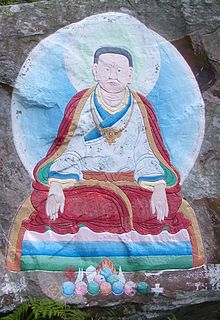- Marpa Lotsawa
-
 A traditional depiction of Marpa painted on a rock on Holy Isle, Firth of Clyde
A traditional depiction of Marpa painted on a rock on Holy Isle, Firth of Clyde
Part of a series on Tibetan Buddhism
History Timeline · Related-topics Schools Nyingma · Kagyu · Sakya · Gelug · Bön · Jonang Key concepts Three marks of existence · Skandha · Cosmology · Saṃsāra · Rebirth · Bodhisattva · Dharma · Dependent origination · Karma Major figures Gautama Buddha · Padmasambhava · Je Tsongkhapa · Dalai Lama · Panchen Lama · Lama · Karmapa Lama · Rinpoche · Geshe · Terton · Tulku Buddhahood · Avalokiteśvara · Four stages of enlightenment · Tantric yoga · Paramitas · Meditation · Laity Changzhug · Drepung · Dzogchen · Ganden · Jokhang · Kumbum · Labrang · Mindroling · Namgyal · Narthang · Nechung · Pabonka · Palcho · Ralung · Ramoche · Sakya · Sanga · Sera · Shalu · Tashilhunpo · Tsurphu · Yerpa Chotrul Duchen · Dajyur · Losar · Monlam · Sho Dun Texts Kangyur · Tengyur · Tibetan canon · Mahayana sutras · Nyingma Gyubum Sand mandala · Thangka · Ashtamangala · Tree of physiology Outline · Comparative studies · Culture · List of topics · Portal
Marpa Lotsawa (1012–1097), sometimes known fully as Lhodak Marpa Choski Lodos or commonly as Marpa the Translator, was a Tibetan Buddhist teacher credited with the transmission of many Buddhist teachings to Tibet from India, including the teachings and lineages of Vajrayana and Mahamudra.
Contents
Biography
Born as Marpa Chökyi Lodrö, in Lhodrak Chukhyer in the southern part of Tibet, to an affluent family, he began studying at a young age but was wild and untamed compared to other children. Marpa first received instruction for three years at Mangkhar with Drokmi Shakya Yeshe and mastered Sanskrit. He decided to travel to India to study with renowned Indian Buddhist masters. Marpa returned home to Lhodrak and converted his entire inheritance into gold to fund his travel expenses and to make offerings to teachers.
Marpa journeyed first to Nepal where he studied with Paindapa and Chitherpa, two famous students of Naropa. Paindapa later accompanied Marpa to Pullahari, near Nalanda University, where Naropa taught. Marpa spent twelve years studying with Naropa and other great Indian gurus, most prominently Maitripada. After twelve years he set forth on his journey back to Tibet to teach and continue his dharma activities.
Marpa was to travel to India twice more and Nepal three more times and studied with Naropa and other great teachers including Maitripa. On his third visit to India, Naropa, who was engaged in tantric practices, proved difficult to find. However eventually Marpa found him and received the final teachings and instructions from Naropa. It was then that Naropa prophesied that a family lineage would not continue for Marpa, but that his lineage would be carried on by his disciples. Marpa now had received the full transmission, so Naropa formally declared Marpa to be his successor although he had other major disciples including Paindapa, Chitherpa, Shri Shantibhadra or Kukuripa, and Maitripa.
Upon his return to Tibet, Marpa spent many years translating Buddhist scriptures and made a major contribution to the transmission of the complete buddhadharma to Tibet. Marpa continued to practice and give teachings and transmissions to many students in Tibet. After his second visit to India Milarepa became his disciple, who inherited his lineage in full. Marpa lived with his wife Dakmema and their sons in Lhodrak in the southern part of Tibet. Marpa is said to have founded Stongdey Monastery in Zanskar in 1052 CE.[1]
References
Further reading
- The Life of Marpa the Translator. By Nalanda Translation Committee, Shambhala Publications, Inc. 1982. ISBN 1570620873, ISBN 1569571120
External links
- Biography at kagyu office.org
- Marpa - His Life, Teachings and Images The most extensive biography of Marpa available online.
Preceded by
NaropaKagyupa school Succeeded by
MilarepaBuddhism Indian philosophy Texts Vedas (includes the Mukhya Upanishads) · Upanishads (Whole list...) · Puranas: Vishnu Purana, Bhagavata Purana · Ramayana · Mahabharata · Bhagavad-Gita · Buddhist texts · Jain AgamasTopics Āstika Samkhya · Nyaya · Vaisheshika · Yoga · Mimamsa · Vedanta (Advaita · Vishishtadvaita · Dvaita · Acintya bheda abheda)Nāstika Cārvāka · Ājīvika · Jaina (Anekantavada · Syadvada) · Bauddha (Shunyata · Madhyamaka · Yogacara · Sautrantika · Svatantrika)Philosophical
TextsYoga Sutra | Nyaya Sutra | Vaiseshika Sutra | Samkhya Sutra | Mimamsa Sutra | Brahma Sutra | More...Philosophers Akshapada Gotama | Patanjali | Yajnavalkya | Kanada | Kapila | Jaimini | Vyasa | Nagarjuna | Madhvacharya | Kumarajiva | Padmasambhava | Vasubandhu | Adi Shankara | Ramanuja | More...Bodhisattvas General list Chinese Vajrayana Other Bhaishajyaraja · Candraprabha · Nagarjuna · Niō · Shantideva · Supratisthitacaritra · Supushpachandra · Suryaprabha · Vasudhara · VisistacaritraCategories:- Bodhisattvas
- Buddhist philosophers
- History of Tibet
- Tibetan Buddhist yogis
- 1012 births
- 1097 deaths
- Kagyu
- Lamas
- Mahasiddhas
- Tibetan Buddhists from Tibet
- Buddhist yogis
- 11th-century Tibetan people
Wikimedia Foundation. 2010.

